Exploring the Vibrant Artistry of Famous Balinese Paintings
Balinese paintings are a captivating and integral part of Bali’s rich cultural heritage. The famous Balinese paintings known for their vibrant colors, intricate details, and spiritual themes, these artworks offer a glimpse into the island’s artistic traditions and religious beliefs. Let’s dive into the world of Balinese paintings and discover the beauty they hold.
The art of painting has a long history in Bali, with influences from Hinduism and local mythology. Artists in Bali often depict scenes from ancient epics, traditional rituals, folklore, and the island’s breathtaking landscapes. One of the unique aspects of Balinese paintings is the use of intricate brushwork, delicate lines, and vibrant pigments that create a visually stunning effect.
Traditional Balinese paintings
The “kamasan” style, often seen in palace paintings, depicts the lives of mythical characters and patrons or their ancestors. The “Pita Maha” or “School of Ubud,” supported by Walter Spies and Rudolf Bonnet in the 1930s, revitalized Balinese art by providing opportunities for talented artists and sparking a surge in artistic production. These paintings typically portray everyday life scenes in a simple and straightforward manner.
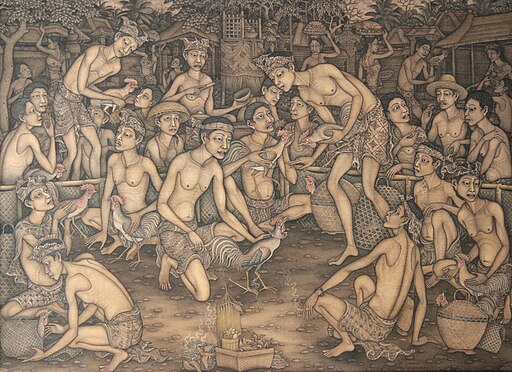
Traditional Balinese painting depicting cockfighting, by I Ketut Ginarsa. I ketut ginarsa, Copyrighted free use, via Wikimedia Commons
1920: the renaissance of Balinese painting
But it will be necessary to wait until the 1920s to really witness a renaissance of Balinese painting, when the artistic community Pita Maha was created, by both Balinese and Europeans. These influenced the former by encouraging them to explore new subjects, new techniques and new materials, and enabled them to distribute their works to a Western clientele in demand of exotic art.
Among the European artists who have played a major role, we can cite Rudolf Bonnet (Dutch), Walter Spies (German), and A.J le Mayeur (Belgian). The most famous Balinese painter, who distinguished himself during this period, is I Gusti Nyoman Lempad, also known as a sculptor and architect of great talent.

The Belgian painter Le Majeur with his model Ni Pollock, Bali. Tropenmuseum, part of the National Museum of World Cultures, CC BY-SA 3.0, via Wikimedia Commons
Western influence
Balinese paintings is certainly the artistic field where western influence has been strongest. With the arrival of Western artists (in the course of the 20s and 30s) coincides the appearance of the concept of painting as pure and sought-after art as such, which can, moreover, be the subject of a sale! There are several schools of Balinese paintings.
The Dutch painter Arie Smit, who arrived in Bali in 1956, developed a particular style, promoting the talent of young artists, sometimes even children, to whom he provided technical advice and the necessary material, without trying to influence their inspiration. The result is a naive style, depicting rural scenes in shimmering colors…
Best Bali Local Markets | Discovering Balinese Traditional Markets and Must Visit Markets
Different schools or styles of Balinese Ppaintings
Let’s delve deeper into the world of Balinese paintings and discover the different schools or styles that contribute to their diversity.
Ubud School
The Ubud School of painting is one of the most well-known and influential styles in Bali. It emerged in the early 20th century and is characterized by its meticulous attention to detail, realistic figures, and depictions of traditional Balinese themes such as village life, dance, and mythology. Artists like I Gusti Nyoman Lempad and I Gusti Made Deblog have made significant contributions to this school.
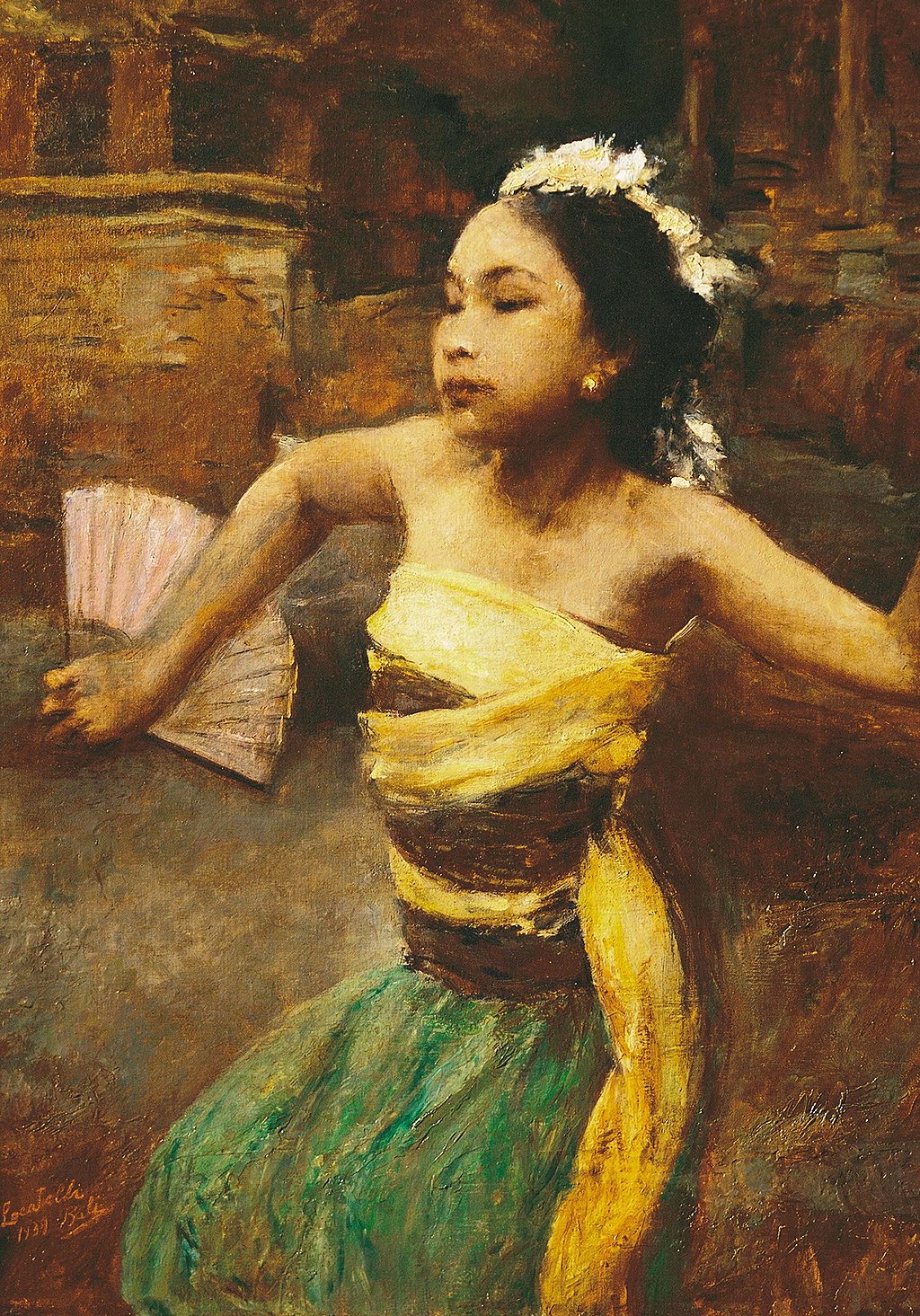
Locatelli, who had always excelled at painting children, also made a memorable paintings of Legong Dance. Considered the most classical and elegant of all Balinese dances, Legong is a complicated dance that is performed by girls not more than 8 years old. Locatelli’s 1939 canvas, “Legong Dancer,” now a highlight of the newly established Museum Pasifika, is considered a late Orientalist masterpiece: a sharp-eyed depiction of Asian culture seen through a Westerner’s eyes. In some respects, the “Legong Dancer” is reminiscent of the painter Degas’ depictions of young women enduring the rigors of ballet training. Museum Pasifika, Public domain, via Wikimedia Commons
Famous artists Ubud style
Ubud artists continuing the Pitamaha tradition include Ida Bagus Sena, A.A Gede Anom Sukawati, I Ketut Budiana, I Nyoman Kayun, and I Nyoman Meja. I Ketut Budiana’s artworks have been exhibited extensively and can be found in prestigious institutions like Fukuoka Museum of Arts, Bentara Budaya Jakarta, Museum Puri Lukisan, Neka Museum, and Arma Museum.
Ida Bagus Putu Sena has developed a unique style infused with Balinese philosophy, while Anom Sukawati is renowned as Bali’s most accomplished colorist. Meja’s artistic style has influenced many of his students, and Nyoman Kayun was honored with the Bali Bangkit award in 2008.
Batuan School
The Batuan School of painting originated in the village of Batuan, known for its traditional arts. This style is characterized by its bold brushwork, strong lines, and dark, earthy colors. Batuan paintings often depict religious and mythological subjects, showcasing the artists’ deep connection to their cultural and spiritual roots.

A typical painting from Batuan by a local artist, around 1940. A number of people work the rice field with heels (pacul), while others drive water buffaloes with a kind of plow. Still others are busy setting out the young rice plants (bibit). There are ducks under a white flag pole. The water buffaloes have a basket around their mouth to prevent them from eating from the rice field. On the back is the name of the painter and the place of origin: Batoean Gianjar (Batuan Gianyar). Furthermore, a pencil drawing of the same plow can be seen as the one on the front. Tropenmuseum, part of the National Museum of World Cultures, CC BY-SA 3.0, via Wikimedia Commons
Today, Batuan paintings typically feature intricate details, vibrant colors, and dense compositions. Artists often depict religious and mythological themes, showcasing the rich cultural heritage of Bali.
With their meticulous brushwork and traditional techniques, Batuan painters create visually captivating artworks that continue to captivate art enthusiasts worldwide.
Famouse Balinese paintings school for Batuan artists
Notable Batuan artists from this period include I Nyoman Patera (1900-1935), I Tombos (b. 1917), Ida Bagus Togog (1913-1989), Ida Bagus Made Jatasura (1917-1946), Ida Bagus Ketut Diding (1914-1990), I Made Djata (1920-2001), and Ida Bagus Widja (1912-1992).
The Pitamaha spirit lives on through contemporary Batuan artists like I Made Budi, I Wayan Bendi (b. 1950), I Ketut Murtika (b. 1952), I Made Sujendra (b. 1964), among others.
Paintings by I Made Budi and I Wayan Bendi depict the impact of tourism on Balinese life, showing tourists engaging in traditional village activities alongside modern elements. I Ketut Murtika continues to create intricate artworks portraying the traditional stories of Mahabharata and Ramayana, demonstrating his expertise in local legends and meticulous attention to detail.

This Batuan painting style has a solid characteristic and leaves almost no empty space. The techniques of this painting are sketching, Nyawi (drawing) to sharpen the lines of the pencil, Nguntur to distinguish far from near objects. Then Sigar to split the painting line. Then there are motifs such as batik and coloring. The work can take up to one to two months. Paco Pater, CC BY-SA 4.0, via Wikimedia Commons
Best Bali Art Galleries: Diverse Offerings and Creative Treasures
Sanur School
The Sanur painting style is a distinctive artistic tradition that originated in the coastal village of Sanur in Bali, Indonesia. It emerged in the early 20th century and is known for its vibrant colors, intricate details, and emphasis on capturing the beauty of nature, particularly landscapes and seascapes.
Sanur paintings often depict scenes of traditional Balinese life, including religious ceremonies, village activities, and daily rituals. The artists employ a combination of traditional Balinese techniques and modern influences, resulting in a unique fusion of styles.
Several notable artists have contributed to the development and popularity of the Sanur painting style. Here are a few examples: Major artists from Sanur are I Gusti Made Rundu, Ida Bagus Nyoman Rai, Ida Bagus Made Pugug and I Soekaria.
These artists, along with many others, have played a pivotal role in shaping the Sanur painting style and establishing its reputation as a unique and captivating form of Balinese art.
Keliki School
The Keliki School of painting is distinguished by its miniature size and intricate details. Artists from the village of Keliki create delicate paintings on small canvases, depicting scenes from everyday life, nature, and Balinese folklore. The precise brushwork and meticulous attention to detail make these paintings truly remarkable.
The paintings typically depict scenes from Balinese mythology, folklore, and daily life, showcasing the rich cultural heritage of the region.
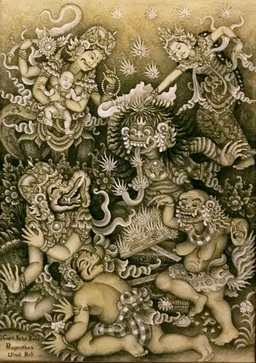
Terbakarnya Lontar (Burning Lontar) by I Gusti Ketut Kobot, 1958, Museum Puri Lukisan. Pinerineks, CC BY-SA 4.0, via Wikimedia Commons
The Keliki School paintings often feature elements such as lush landscapes, traditional Balinese architecture, flora, fauna, and the iconic figures of Balinese dance and ritual.
Famous artist from Reiky style
Prominent artists from the Keliki Artist School include Sang Ketut Mandera (Dolit), I Ketut Sana, I Wayan Surana, I Lunga, I Made Widi, I Wayan Nengah, I Made Ocen, Gong Juna, I Wayan Lanus, I Wayan Lodra, Ida Bagus Putra, Gusti Ngurah Putra Riong, and more.
Bali Arts Festival in Denpasar | The Biggest Annual Cultural Event in Bali
Young Artists’ School
In recent years, a new generation of artists has emerged in Bali, blending traditional techniques with contemporary styles and themes. The Young Artists’ School showcases the innovative and experimental spirit of Balinese art. These artists often incorporate elements of pop art, street art, and abstract expressionism, creating vibrant and thought-provoking works.

1996. The Bukit Peninsula. A full moon party is winding up before the sun reminds us of another day. We grab a taxi, but hit a queue at the airport road. Then these guys appear, scrambling over the top of our bonnet, trying to restrain Hanuman, who apparently was making a monkey out of them. Honest! Tom Franz Art, CC BY-SA 4.0, via Wikimedia Commons. Visit his website: https://www.tomfranzart.com
The Young Artists’ painting style in Bali represents a fresh and contemporary approach to traditional Balinese art. Emerging artists, often inspired by their cultural heritage and surroundings, bring a modern perspective to their creations. The Young Artists’ style is characterized by bold colors, dynamic compositions, and experimental techniques.
These artists embrace various mediums, including acrylics, oils, and mixed media, to express their unique artistic visions. The artworks exude a sense of vibrancy, energy, and creativity, reflecting the evolving artistic landscape in Bali. With their innovative and expressive techniques, the Young Artists’ paintings offer a captivating glimpse into the evolving art scene in Bali.
Prominent artists from the Young Artist style
Prominent artists from the Young Artist School include I Wayan Pugur, I Ketut Soki, I Ngurah KK, I Nyoman Londo, I Ketut Tagen, M D Djaga, I Nyoman Cakra, Ni Ketut Gampil, I Nyoman Mundik, I Wayan Regug, and more.
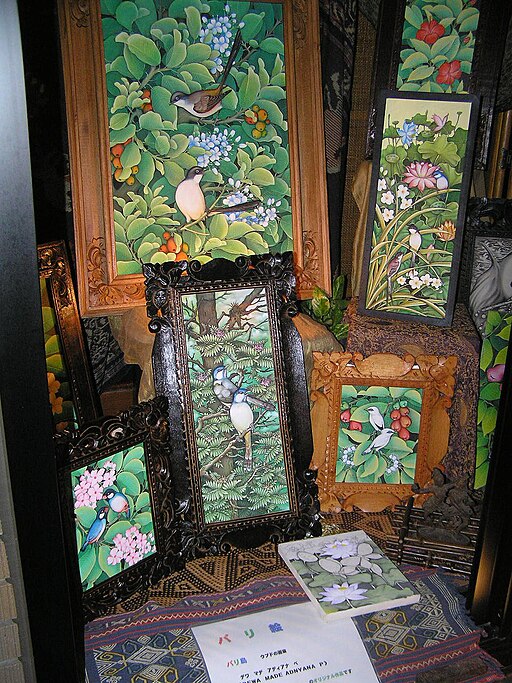
Bali paintings. 関西画像創庫, CC BY-SA 3.0, via Wikimedia Commons
Traditional Wayang School
Wayang, the traditional shadow puppetry of Indonesia, has had a profound influence on Balinese paintings. Artists skilled in the art of wayang painting create intricate and stylized images of characters from Hindu epics and mythology.
The Traditional Wayang painting style is rich in symbolism and carries deep cultural significance. Each character and element depicted in the paintings represents specific virtues, moral lessons, or mythological concepts. In Balinese art, the character of Rama from the Ramayana represents righteousness and duty, contrasting with the demon king Ravana who embodies evil forces. The elaborate patterns and motifs found in costumes and backgrounds in Balinese art carry symbolic meanings rooted in Balinese mythology and spirituality.
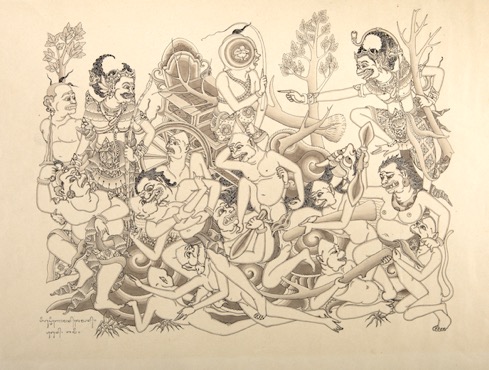
I Gusti Nyoman Lempad “Ramayana” 1960, Ink on paper 30×41 cm. Museum Pasifika, Public domain, via Wikimedia Commons
These paintings often feature bold lines, vibrant colors, and a sense of dramatic storytelling.
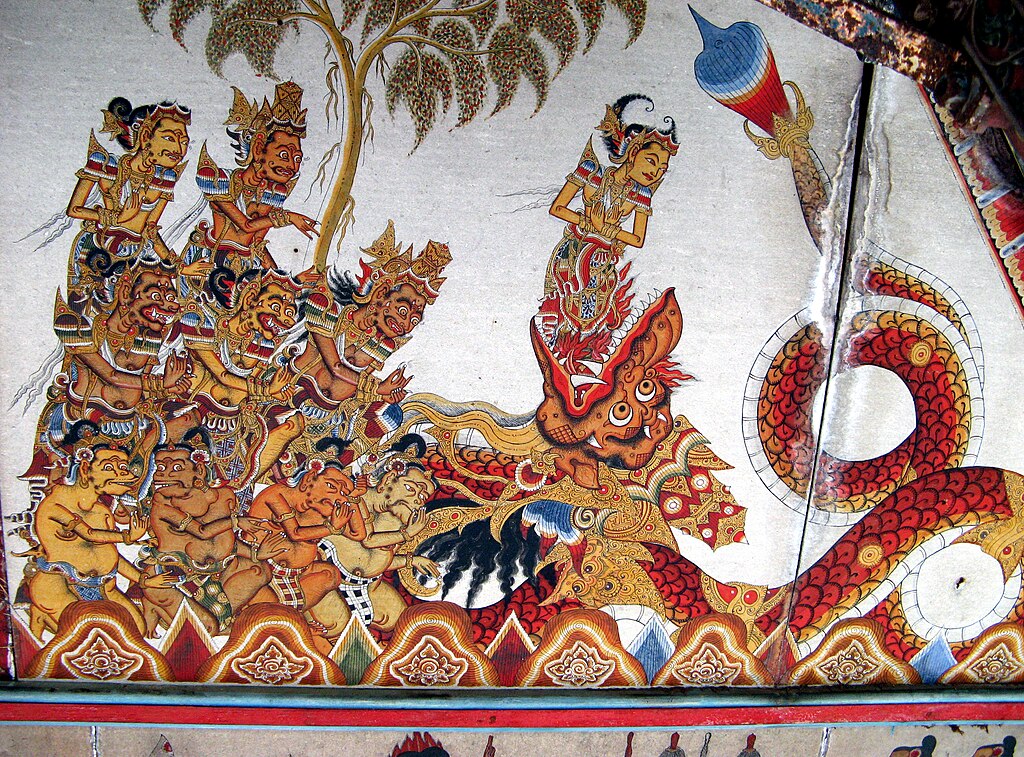
Kerta Gosa, Ramayana Scene, Bali 1544. Meganada’s serpent. Bale Kambang, Taman Gili. Semarapura, Bali.
In this scene from the Ramayana, the demon Meganada (son of Ravana) has shot a deadly arrow at Rama that turned into a dragon and wrapped the hero in its coils. Eventually Rama was freed by the help of Garuda, Vishnu’s mount. Michael Gunther, CC BY-SA 4.0, via Wikimedia Commons
Geometric-abstractionism
I Made Wianta (20 December 1949 – 13 November 2020) was a painting artist known in the realm of modern art. Made is a graduate of the Yogyakarta Art Institute of Indonesia. In 1976, he studied European art in Brussels, Belgium, as well as visiting art galleries and museums.
Made has participated in various international exhibitions such as in New York, Paris and Tokyo. However, the most famous is his participation in the Biennale in Venice in 2003. Made is an artist known for his love of reading, especially in the field of philosophy which led him to Nietzsche’s philosophy of Buddhism and Nihilism. Apart from his reading field, the artist in Made is also reflected in the agrarian tradition in his native land, Bali.
His work has been documented in several books, including Made Wianta (1990), Made Wianta: Universal Balinese Artist (1999), Made Wianta: Art and Peace (2000), and Wild Dogs in Bali: The Art of Made Wianta (2005). Made Wianta also displayed several collections of his works at The Neka Museum in Ubud, Bali.
Museums in Bali | Explore the Island’s Rich Cultural and Artistic Heritage
Conclusion
As you explore the art galleries and museums in Bali, you will encounter a diverse range of Balinese paintings influenced by these different schools. Each style carries its own unique charm and reflects the artistic evolution of the island over the years.
The beauty of Balinese paintings lies not only in their visual appeal but also in the stories they tell and the emotions they evoke. These artworks are a reflection of the island’s cultural identity and serve as a bridge between the past and the present. Whether you are a seasoned art enthusiast or a curious traveler, exploring Balinese paintings is a journey that will leave a lasting impression.
Today there are a good number of micro-communities of artists in Bali exploring different paths and sometimes criticizing each other quite violently, whose heterogeneous works are sometimes disconcerting, but there is no doubt that among them are waiting to be discovered, when they are not are not already exhibited in art galleries in New York, Singapore, Tokyo or…Paris.
So, when you visit Bali, take the time to immerse yourself in the world of Balinese paintings. Appreciate the skill and craftsmanship behind each artwork, and let the stories and cultural significance captivate you. Balinese paintings are not just beautiful creations; they are windows into the artistic soul of Bali’s artistic heritage.
Photo credit (main picture): The National Museums of World Culture, Public domain, via Wikimedia Commons. References: http://collections.smvk.se/carlotta-vkm/web/object/103515 and Google Arts & Culture asset ID: PQEnDpQYA74ZTQ
Museums in Bali | Explore the Island’s Rich Cultural and Artistic Heritage
Ready to book your villa in Seminyak center?

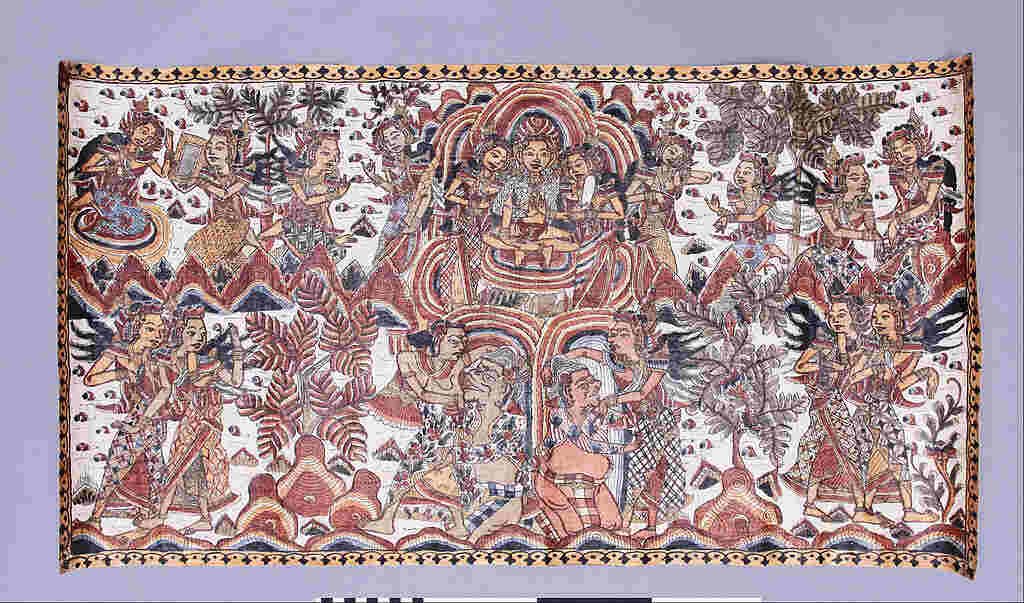



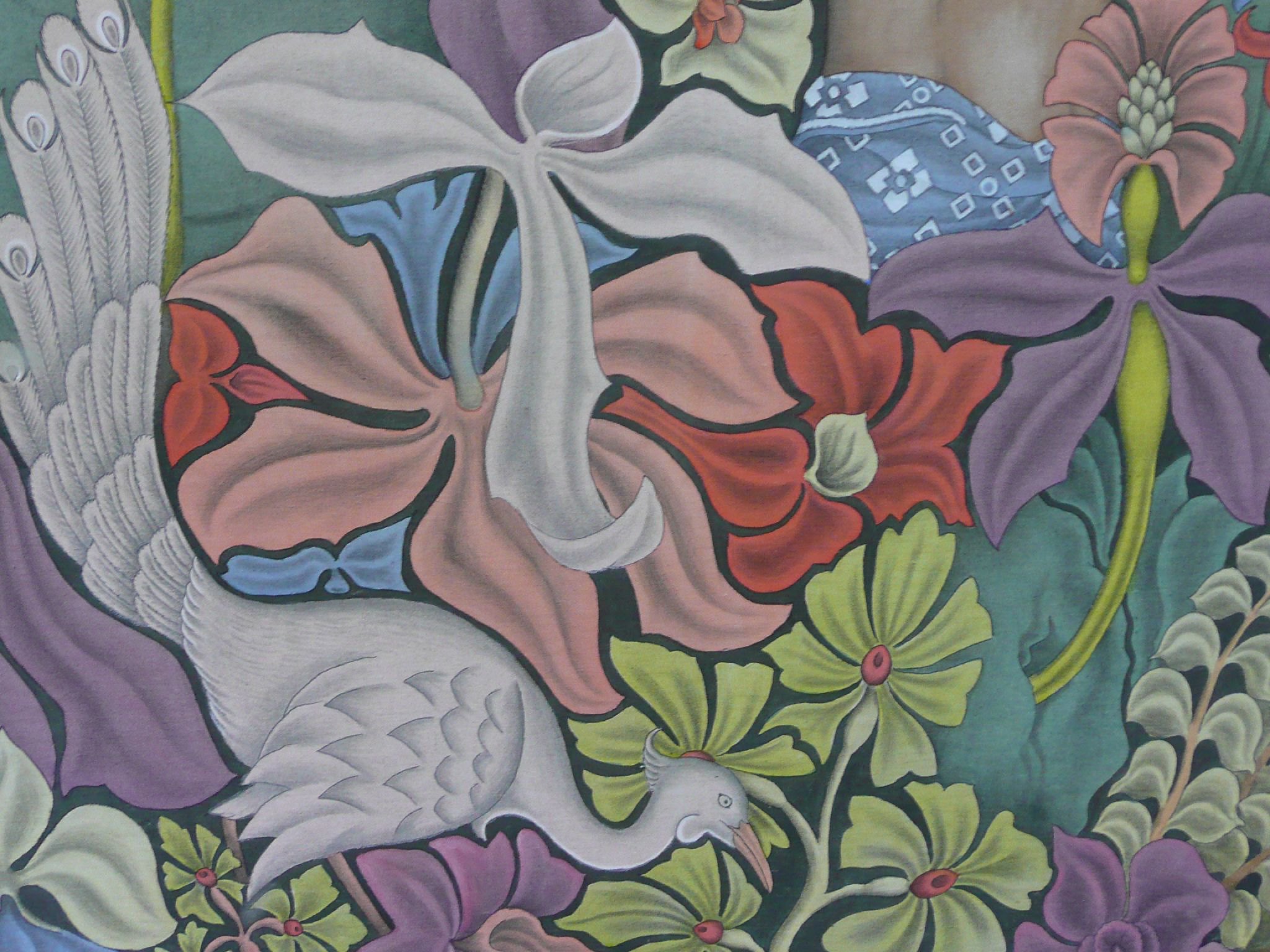

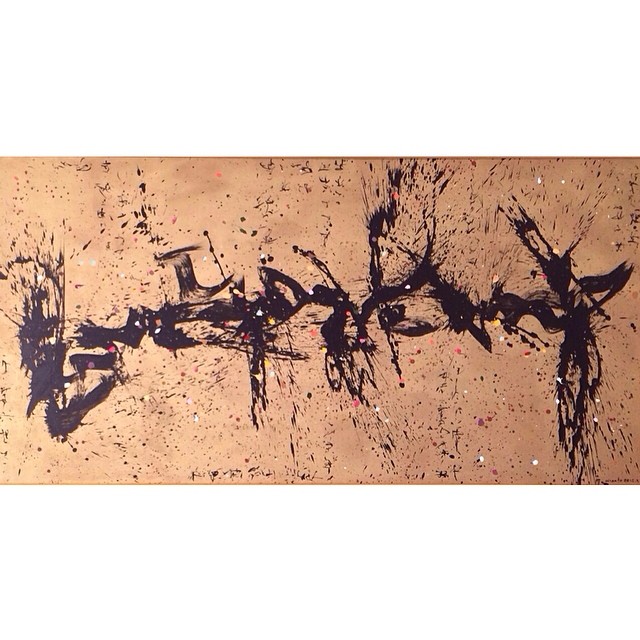
What are some really famous Balinese paintings, and what do they reveal about Bali’s rich artistic heritage?
Balinese paintings are famous for their bright colors, detailed designs, and stories about Balinese life and traditions. Artists like I Gusti Nyoman Lempad, I Gusti Made Deblog, and Ida Bagus Made paint scenes from Hindu stories, Balinese ceremonies, and daily activities. These paintings show Bali’s culture and are a treasure of the island’s history.